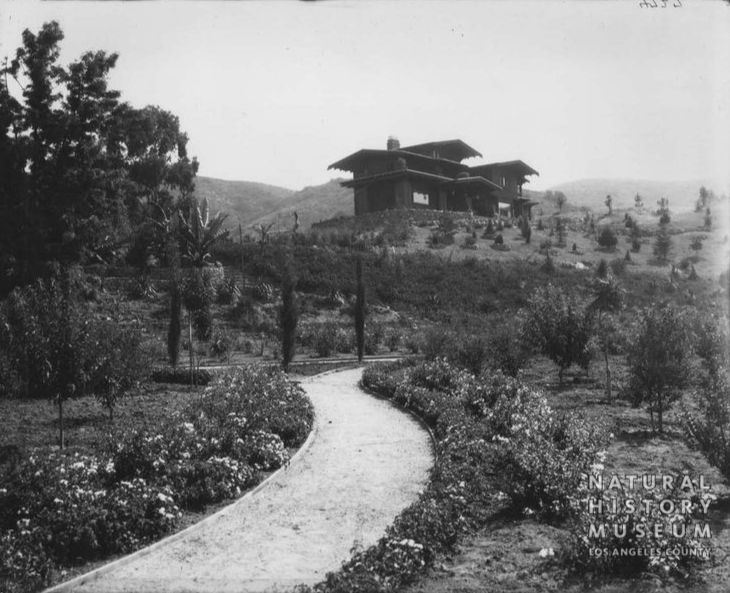Beachwood Canyon Artistic Apartments
- KP
- Dec 29, 2023
- 3 min read
Updated: Jun 18, 2025
It should come as no surprise that one of Beachwood Canyon’s most unique apartment buildings was envisioned by an artist.

In 1925, commercial illustrator John C. Hill and his wife Delia built the Moorish four-family residence at 2260 Beachwood Drive, with plenty of charm in each unit: rooms finished in Philippine mahogany, tiled bathrooms, breakfast nook, large private porch which could be used for sleeping purposes, and a share in the broad and deep front entry. According to a 1927 ad, a unit rented for $85/month.
Set back 80 feet from the street, it promised occupants “comparative quiet” from the bustling Beachwood Drive. Behind the building, a six-car garage also offered ample turning space.

The property contained one other structure: The Hill residence, the very first home built on Beachwood Drive, which John and Delia moved to the rear of their lot to make room for the Moorish apartments in August 1925.
Prior to the 1910 Craftsman (which still exists!), the land had been the famed pineapple farm of John Baptist Rapp. Beginning with 25 plants in 1891, the German immigrant’s crop grew slowly but surely: Within seven years, he was the only commercial grower of pineapples in California.
John and Delia, celebrated Hollywood pioneers who came to Los Angeles in 1898, were very proud of their distinction. Several articles about the couple over the years noted they had built the first home on Beachwood Drive. It was there in 1929 that Delia organized the Beachwood Drive Development Association, which encouraged beneficial improvements in the community, particularly the proposed extension of the street to Hollywood Boulevard.

“We were such sweet young things when we arrived in California, we believed we could turn the world,” Delia told the Los Angeles Citizen News as she and John celebrated their 57th wedding anniversary in 1943 (by then, the Hills had moved away from Beachwood, less than a mile south to 6046 Carlos Avenue). “We still long to help build Hollywood into the kind of community it could so easily be—a place of peace and beauty, rather than an industrial center.”
The entire Hill family did their part to preserve the community’s rich history.
Eldest son Laurance Landreth Hill was the first City Editor of the Hollywood Citizen News and later became director of the Historical Society of Southern California. He also wrote several books documenting the region, including In the Valley of the Cahuengas, and gave talks like 1930’s “Keeping California California.” When the 45-year-old died following an operation in 1932, a deodar tree was planted in his honor at the Hollywood Bowl, the venue his parents helped establish the previous decade. John had been the head usher for the front row seats, then reserved for the crippled and aged, while Delia trudged up and down the surrounding hills selling concert tickets door-to-door.
John and Delia’s second son Corydon Thomas Hill, a veteran, served as Commander of American Legion’s Hollywood Post 43 on Highland Avenue, where he remained a fixture for decades. Youngest daughter Clara Mary Hill graduated from Hollywood High School.
In 1946, as talk of the Hollywood Freeway grew louder, 80-year-old Delia (by then, a widow) wrote to the Los Angeles Citizen News in protest (her Carlos Avenue home was just one block south of the projected path). “Without asking permission of the property owners or citizens of Hollywood, the state officials propose to cut, slash, bridge over and root under Hollywood, the beautiful city we have worked so hard to create; and to mess it up with useless dead-ends, without end, all to enable up-country folk to zip through, and get downtown quickly. Adding crime to outrage, they are now proceeding to order people from their homes, to permit wrecking these homes, so sadly needed by veterans, and the parents and grand-parents of veterans—the same of which we are.”
Although 6046 Carlos survived the Hollywood Freeway, it was demolished in 2016 and today remains an empty lot occupied by homeless tents.

Back at 2260 Beachwood, the Hills’ Moorish apartment building is as lovely (and artistic) as ever. Renovations over the years have expanded the four units to at least 10 — plus the original home at the rear of the lot.

Now known as The Moroccan, it is managed by Art Deco Apartments. Most recently in 2023, a two-bedroom rented for $3,595/month and the listing revealed the preserved interior, noted for being “restored to museum-quality.”


















Comments